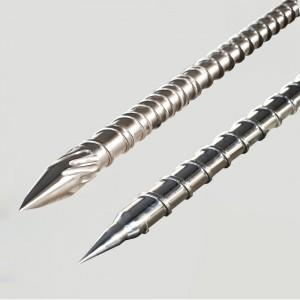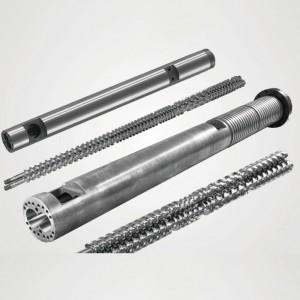Manufacturers see big changes in 2025 with the PE PP injection molding screw barrel. This tool from Injection Screw Factory keeps material moving smoothly inside the Injection Molding Barrel. The Injection Machine Screw helps control pressure and temperature. These upgrades help create strong, high-quality products with less waste.
Common Defects in PE PP Injection Molding
Warping and Shrinkage
Warping and shrinkage often trouble manufacturers working with PE and PP. These defects make parts twist or change shape after cooling. Several factors play a role, such as the type of material, how fast the mold cools, and the temperature during melting. For example, materials with higher shrinkage coefficients tend to warp more. Lower crystallinity helps reduce shrinkage. Fusion temperature, cooling channel temperature, and cooling time matter most for warpage. Packing pressure becomes important when using recycled materials. Studies show that melting temperature, holding time, and injection time all affect how much a part shrinks or warps.
- Shrinkage and warpage increase with higher crystallinity.
- Cooling rate and mold temperature can cause uneven shrinkage.
- Large molded parts almost always show some warpage due to thermal shrinkage.
Incomplete Filling
Incomplete filling happens when the molten plastic does not fill the mold completely. This leaves gaps or missing sections in the final product. Mold temperature, injection pressure, and cooling time all influence this defect. If the pressure is too low or the material cools too quickly, the plastic cannot reach every corner of the mold. Longer holding phases help reduce gaps and improve uniformity.
Surface Imperfections
Surface imperfections include rough patches, flow marks, or visible lines on the product. These flaws often result from unstable flow during injection. Researchers have used visual checks, optical microscopes, and electron microscopes to spot these issues. They found that surface roughness links closely to how the material flows and the friction inside the mold. When the flow becomes unstable, surface defects appear more often.
Tip: Keeping the flow steady and the mold at the right temperature helps prevent surface imperfections.
Material Degradation
Material degradation means the plastic starts to break down during molding. This can lower the strength and quality of the product. For polypropylene, scientists measure degradation by checking how much the viscosity drops. High temperatures, fast screw speeds, and long times in the barrel speed up this process. Different PP grades degrade at different rates. Tools like inline Raman spectroscopy and rheological tests help track these changes in real time.
| Parameter Influencing Degradation | Description and Empirical Findings |
|---|---|
| Polymer Type | Focus on polypropylene (PP); no direct empirical data for polyethylene (PE) degradation rates during injection molding |
| Degradation Indicators | Reduction in viscosity used as proxy for molecular chain scission and molar mass decrease |
| Influencing Factors | Temperature, shear rate, residence time; degradation accelerates with higher temperature and shear |
| Measurement Methods | Rheological testing in coaxial cylinder system; inline Raman spectroscopy for real-time PP degradation measurement |
| Degradation Behavior | Different PP grades show distinct degradation rates; low loadings cause slow degradation, high loadings cause rapid viscosity decrease |
How PE PP Injection Molding Screw Barrel Solves Defects

Optimized Screw Design for Uniform Melting
A well-designed screw makes a big difference in the injection molding process. The PE PP injection molding screw barrel uses an optimized screw shape that helps melt plastic evenly. Engineers have tested different screw shapes, like three-zone screws and special mixing sections, to find the best way to heat and mix the material. They use advanced tools to measure how well the screw melts the plastic. When the screw design is just right, the melted plastic flows smoothly and reaches the same temperature everywhere.
- Uniform melting means fewer cold spots and no unmelted plastic in the final product.
- Mixing screws help keep the color and thickness of the melted plastic the same.
- Special features, like rounded edges and smooth transitions, stop plastic from getting stuck and burning.
Many factories report that these improved screw designs lead to faster production and fewer rejected parts. They also see stronger weld lines and more even shrinkage, which means better quality products.
Advanced Temperature and Pressure Control
Precise control over temperature and pressure is key to making high-quality plastic parts. The PE PP injection molding screw barrel comes with advanced systems that monitor and adjust these settings in real time. This technology keeps the melted plastic at the perfect temperature and pressure as it moves through the barrel.
| Study / Authors | Control Method | Key Improvement Metrics | Description |
|---|---|---|---|
| Jiang et al. (2012) | Predictive control with feed-forward compensation | Accurate melt pressure and temperature control | Outperformed older controllers; used lab extruder for testing |
| Chiu and Lin (1998) | Closed-loop controller with ARMA model | Viscosity variance reduced by up to 39.1% | Used in-line viscometer to keep melt flow steady |
| Kumar, Eker, and Houpt (2003) | PI controller with viscosity estimation | Viscosity accuracy within ±10% | Adjusted feed to keep melt quality stable |
| Dastych, Wiemer, and Unbehauen (1988) | Adaptive control | Better handling of changing conditions | Controlled melt and barrel temperatures for steady output |
| Mercure and Trainor (1989) | PID control based on math model | Faster start-up, less downtime | Kept barrel temperature steady for smooth operation |
| Ng, Arden, and French (1991) | Optimal regulator with dead time compensation | Improved tracking and less disturbance | Controlled pressure in gear pump system |
| Lin and Lee (1997) | Observer control with state-space model | Pressure and temperature within ±0.5 units | Used computer simulations to fine-tune screw speed and temperature |
These systems help keep the plastic flowing smoothly and prevent problems like incomplete filling or surface marks. When the temperature and pressure stay steady, the final parts look better and last longer.
Note: Real-time monitoring and control mean fewer surprises and more consistent results.
Enhanced Mixing and Homogenization
Mixing is another important job for the screw barrel. The PE PP injection molding screw barrel uses special mixing zones and tight clearances to blend the plastic evenly. This design helps every bit of plastic get the same treatment as it moves through the machine.
- Twin-screw systems use helical flights to move and mix the material.
- The pitch and speed of the screw affect how well the plastic blends.
- Keeping a precise gap between the screw and barrel helps control the mix and cut down on waste.
Simulation studies show that these features improve how well the plastic mixes and how long it stays in the barrel. When the mix is even, the final product has a smooth surface and strong structure. Factories also see less wasted material and higher output.
Wear-Resistant and Precision-Engineered Materials
Durability matters in injection molding. The PE PP injection molding screw barrel uses tough materials and careful engineering to last longer and work better. The barrel is made from hardened steel and treated with nitriding and chrome plating. These steps make the surface hard and smooth, so it resists wear and keeps working well even after many cycles.
| Material Type | Benefits | Best For |
|---|---|---|
| Nitrided Steel | Cost-effective, good wear resistance | Standard plastics like polyethylene, PP |
| Tool Steel | Excellent wear and corrosion resistance | Abrasive or tough materials |
| Bimetallic Barrels | Durable and versatile | Many types of resins |
| Specialty Alloys | Top corrosion and abrasion resistance | Harsh environments |
Precision features, like barrier screws and mixing sections, help the barrel melt and blend plastic more efficiently. Most wear happens in high-pressure areas, but these strong materials and smart designs keep the screw barrel running smoothly. This means less downtime and more reliable production.
Tip: Using wear-resistant materials and precise engineering helps keep the machine running longer and the products looking great.
Measurable Benefits of PE PP Injection Molding Screw Barrel in 2025

Improved Cycle Times and Productivity
Factories want to make more products in less time. The PE PP injection molding screw barrel helps them do just that. Its advanced design melts and mixes plastic faster. Machines run smoother and need fewer stops for cleaning or repairs. Operators see shorter cycle times, which means they can finish more parts every hour. Many companies notice that their workers spend less time fixing problems and more time making quality products. This boost in productivity helps businesses meet big orders and keep customers happy.
Reduced Material Waste and Costs
Saving material is important for both the environment and the bottom line. The screw barrel’s precise control over melting and mixing means less plastic gets wasted. When the machine runs well, fewer parts come out with defects like pinholes or rough surfaces. Companies report up to a 90% drop in these problems. Less waste means lower costs for raw materials and less money spent on recycling or disposal. Operators also use less energy because the machine works more efficiently.
Tip: Reducing waste not only saves money but also helps protect the planet.
Higher Product Consistency and Quality
Customers want every part to look and work the same. The PE PP injection molding screw barrel makes this possible. It keeps the melt temperature steady by letting operators adjust screw speed and back pressure. The table below shows how these changes help:
| Process Parameter | Change | Effect on Melt Temperature Consistency |
|---|---|---|
| Screw rotation speed | Decrease | Improved consistency due to less shear heat |
| Back pressure | Increase | Improved consistency by raising melt density |
| Dwell time | Increase | Better heat conduction, more even melt |
| Injection stroke | Decrease | More consistent results, limited by mold size |
With these controls, companies see smoother surfaces, even thickness, and stronger products. They also notice better tear resistance and elasticity. Every batch meets the same high standards, which builds trust with customers.
Modern PE PP injection molding screw barrels help manufacturers reach new levels of product quality and efficiency in 2025. Companies gain a real edge by choosing advanced technology. For the best results, they should talk with experts or trusted suppliers like JT to find the right PE PP injection molding screw barrel.
FAQ
What makes the JT PE PP injection molding screw barrel special?
JT uses strong, wear-resistant materials and precise engineering. This helps the screw barrel last longer and keeps product quality high.
How does the screw barrel help reduce waste?
The screw barrel melts and mixes plastic evenly. This means fewer defects and less wasted material. Factories save money and help the environment.
Can the screw barrel handle different sizes of products?
Yes! JT offers screw barrels in many sizes. They fit machines with different clamping forces and shot weights, so manufacturers can make small or large parts.
Post time: Jul-04-2025
